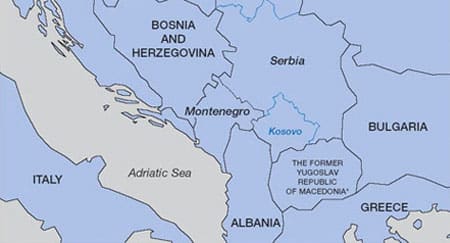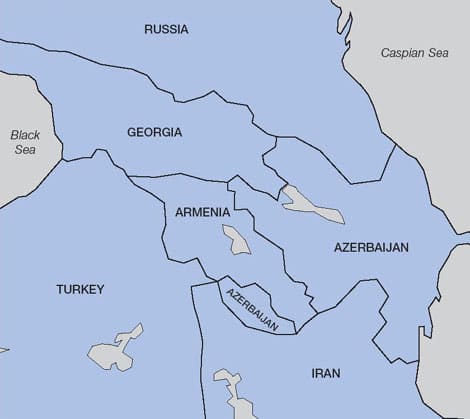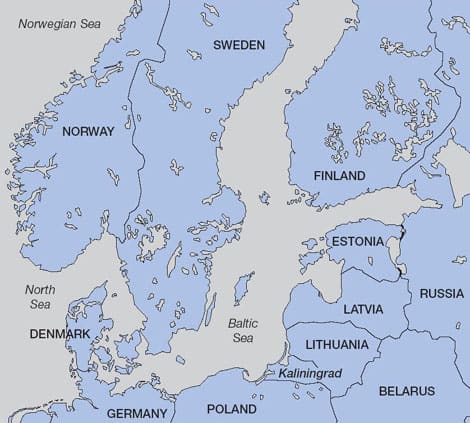James Appathurai examines how NATO promotes regional security cooperation in the Balkans, the Caucasus and the Baltics
In the field of Euro-Atlantic security cooperation, certain big-ticket arrangements get almost all the press: NATO and its Partnership for Peace, the European Union's developing defence dimension, and the Organisation for Security and Cooperation (OSCE). But alongside these large and well-established structures, smaller fledgling regional arrangements are making important contributions to building security in sensitive areas throughout the Euro-Atlantic area. These lower-level efforts at cooperation are an important pillar in the overall security architecture and the Alliance is eager to assist their development.
The logic of regional security cooperation is clear. By pooling resources in the right way, like-minded countries can enhance their own security more effectively. Economically, cooperation allows for economies of scale and the acquisition of equipment that would otherwise be unaffordable for individual, especially smaller countries. Militarily, cooperation multiplies the potential of any individual country's armed forces. Politically, cooperation in the security field is the ultimate confidence and security-building measure because it requires transparency, coordination and mutual trust.
NATO stands as vivid testimony to the success of this approach. What began, in 1949, as a group of nations divided by very recent history — and, not least, by an ocean — has become the most cohesive and effective political/military Alliance ever. And the NATO experience demonstrates that regional cooperation is not a substitute for other endeavours, but a complement to them. Any country can have multiple security affiliations, without any individual affiliation suffering as a result. Hence, for example, the North American Aerospace Defence cooperation between Canada and the United States, or the European Union's security and defence identity.
It is precisely because the potential of regional and subregional cooperation is so clear that the Alliance has lent increasing support to these efforts, even among countries that do not aspire to NATO membership. No single, approved document sets out the rationale behind regional cooperation and the modalities by which the Alliance will support it. Instead, that approach is set out through a variety of documents and policies, each of which applies to a specific area or issue — but which, when taken together, form an intellectually coherent whole. The Alliance works to promote regional security cooperation primarily in the Balkans, the Caucasus and the Baltics, as part of NATO's overall efforts to promote peace and security across the Euro-Atlantic area. NATO takes an individual, targeted approach to each region, because each faces its own security challenges in a unique geopolitical context, and because each is of unique security interest to the Alliance.
The Balkans
Southeastern Europe is of enormous geopolitical importance to NATO. Kosovo, for example, sits in a vital strategic area for the Alliance: just above two NATO members, below new NATO members in Central Europe, and organically linked to Bosnia and Herzegovina (Bosnia). Instability, conflict and widespread human rights abuses in this region have posed direct challenges to NATO's interests over the past decade and the Alliance has been obliged to work to ensure that crises do not destabilise neighbouring countries. The highest-profile tools through which NATO has promoted peace and security in the Balkans are the NATO-led peacekeeping operations in Bosnia and Kosovo. But the Alliance has also engaged in a number of other military and political efforts to promote stability across southeastern Europe, from preventive diplomacy to the active promotion of regional cooperation.
Perhaps the most prominent example of such efforts is NATO's South East Europe Initiative. Launched at the Alliance's 1999 Washington Summit to promote regional cooperation and long-term security and stability in the region, it built on already extensive cooperative relationships with Partners through the Euro-Atlantic Partnership Council (EAPC) and the Partnership for Peace. It also extended to include countries that did not belong to these institutions and programmes, Bosnia and (at the time) Croatia, and foresaw the extension to the Federal Republic of Yugoslavia. An Ad hoc Working Group on Regional Cooperation, set up under EAPC auspices, promotes regional cooperation to stimulate and support practical cooperation among countries of Southeastern Europe. The countries of the region, for example, established the South East Europe Security Cooperation Steering Group (SEEGROUP) in September 2000, the chair of which rotates among members, to support the various cooperative processes now at work. Activities include demining, efforts to control small arms and light weapons, crisis-management simulation and air-traffic management.
Together with other international organisations, the Alliance is working to build regional stability in the framework of the EU-sponsored Stability Pact for South Eastern Europe. In this way, NATO has helped set up programmes to assist discharged officers make the transition from military to civilian life (see also other article in this NATO review: [a CMSref=/2001/NATO-evolving-partnerships/Transition-Civvy-Street/EN/]Easing the transition to Civvy Street[/a]) and others to close military bases and convert them to civilian uses. Other activities require regional leadership. A good example is the South East Europe Common Assessment Paper on Regional Security Challenges and Opportunities (SEECAP). This was a NATO idea, taken forward by countries of the region, including the Federal Republic of Yugoslavia. The SEECAP sets out common perceptions of security challenges among signatory nations and should be a vital f irst step in building peaceful relations in the Balkans. It also sets out opportunities for participating countries to cooperate in addressing these challenges.
The Caucasus
The scenario is different in the Caucasus, where NATO is also promoting regional cooperation. Although there are equally intractable problems in this region, the only Alliance member directly to feel the effects is Turkey. Moreover, there is certainly a perception that NATO as an organisation has limited influence in the region and that NATO members can more usefully contribute to peace and security there through bilateral measures, or by working through other organisations such as the OSCE or the United Nations.
For all these reasons, NATO takes a more low-key approach in the Caucasus. Even at this lower level, however, the Alliance still actively supports security cooperation in the region as a way to promote transparency and confidence-building. The central vehicle for these NATO efforts is the EAPC Ad hoc Working Group on Prospects for Regional Cooperation in the Caucasus. Priority areas identified by the Working Group for practical regional cooperation are defence-economics issues, civil-emergency planning, science and environmental cooperation, and information activities.
Under the auspices of the EAPC, a regional cooperation seminar on energy security in the Caucasus took place in Azerbaijan in 2000, which covered the environmental, economic and civil-emergency aspects of energy security. Seminars have also been held elsewhere in the region on defence economics, civil-emergency planning, civil-military cooperation, small arms and light weapons, and scientific cooperation. The possibility of further conferences is now being discussed on international terrorism and non-proliferation of weapons of mass destruction, as well as on crisis management and mine action. These are all valuable endeavours because the focus is on issues of immediate security interest to the countries of the region.
It must be stressed that when it comes to promoting cooperation in the Caucasus, other regional groupings, such as the OSCE and the GUUAM, an organisation including Georgia, Ukraine, Uzbekistan, Azerbaijan and Moldova, take the lead. But NATO continues to play a role, encouraging the development of common solutions among countries facing common challenges.
The Baltics
The third major region in which NATO takes an active interest in promoting cooperation is the area of the Baltic Sea. Unlike the Balkans, where the challenges are severe and NATO's interest immediate, or the Caucasus, where the challenges are equally intractable but affect the entire Alliance less directly, the Baltics are a region of direct geopolitical importance to the Alliance, but one in which regional cooperation is already progressing nicely and does not require the same level of support from NATO.
This indigenous success should come as no surprise, as this is an area in which regional cooperation has a long history. Certainly, once Estonia, Latvia and Lithuania became states in the beginning of the 20th century, they naturally looked to closer forms of cooperation, for clear geographic, political, economic and military reasons. Today, that cooperation is stronger still — and the reasons are obvious. From a geographical standpoint, these three countries still form a natural region. They are all small states, with small populations and small economies. Furthermore, their socio-economic evolution since the 1920s has been similar and, at present, they have no real disagreements among themselves.
Perhaps as a result, it is safe to say that nowhere in Europe has subregional cooperation been as profound in the post-Cold War era as in the Baltic Sea area. The Council of Baltic Sea States (CBSS), which was initiated in 1992 by the then Danish and German foreign ministers, is an excellent example of a successful regional grouping, bringing together 12 countries to deepen cooperation on a variety of issues. While traditional security was not initially on the agenda, the CBSS now promotes subregional cooperation against organised crime and search and rescue at sea, even including the use of military units.
The CBSS has served as an example for similar endeavours in other parts of Europe, in particular the Balkans. Furthermore, the cooperative activities at the state level are underpinned by a well-developed network of specialised organisations, as well as a web of cooperation between provinces, cities and municipalities across the Baltics. This is especially the case in the security sector, where all three states share a desire to consolidate their independence and rebuff any instability from the East. Regular trilateral cooperation on protection of airspace, for example, has led to the recent establishment of the regional airspace surveillance system (BALTNET) for all three countries.
The three countries also realise that with their limited defence resources, it makes sense to work on their development together. The Baltic Security Assistance Group is an effective body for international coordination of security assistance to the defence forces of Estonia, Latvia and Lithuania. The Baltic Defence College, a military academy primarily for officers from the Baltics that operates in English, is also a good example of cooperation in defence education.
The three Baltic countries also want to demonstrate that they are good European partners, willing to contribute to security. The joint peacekeeping battalion, BALTBAT, and the Baltic squadron (BALTRON) are obvious examples of concrete cooperation in action. The BALTBAT has already been active in the NATO-led peacekeeping operations in the Balkans.
NATO's support for Baltic participation in its peacekeeping operations is one way in which the Alliance and its members are encouraging cooperation among the three Baltic countries. These operations have demonstrated that, by working together, the Baltics can punch above their weight and have an influence on Euro-Atlantic events disproportionate to their individual size.
NATO is also facilitating such cooperation through the Membership Action Plan and the Partnership for Peace. Both projects aim to improve the military capabilities of participating countries and both focus, in particular, on improving interoperability for combined operations. These are essential standards for increased regional cooperation, which the three Baltic countries are working to meet.
Alliance members are also supporting Baltic regional cooperation on a national basis. Denmark, for example, has played a leading role, providing assistance to the Baltic Defence College and accommodating Baltic peacekeepers in Danish formations in the Balkans. The United States has also provided crucial political support. This has manifested itself, in particular, through the 1998 US Baltic Charter, an agreement that, according to then US President Bill Clinton, is designed to encourage close cooperation among the Baltic states and their neighbours and to demonstrate "America's commitment to help Estonia, Latvia and Lithuania to deepen their integration, and prepare for membership in the European Union and NATO."
President Clinton's linking of regional cooperation and membership in Euro-Atlantic institutions is important because it is in the Baltic region, in particular, that concerns are sometimes raised about how successful regional cooperation might undermine aspirations to join NATO. Far from being a constraint against Alliance membership, successful regional cooperation is a powerful selling point for aspiring members. NATO is an organisation within which member states work together, pool resources and develop policy through consensus. Successful regional cooperation not only prepares aspirants for membership, it also demonstrates to existing members that these countries are willing and able to accept the conditions and working methods of the Alliance — while of course building security for all participants.
1. Turkey recognises the Republic of Macedonia with its constitutional name.



